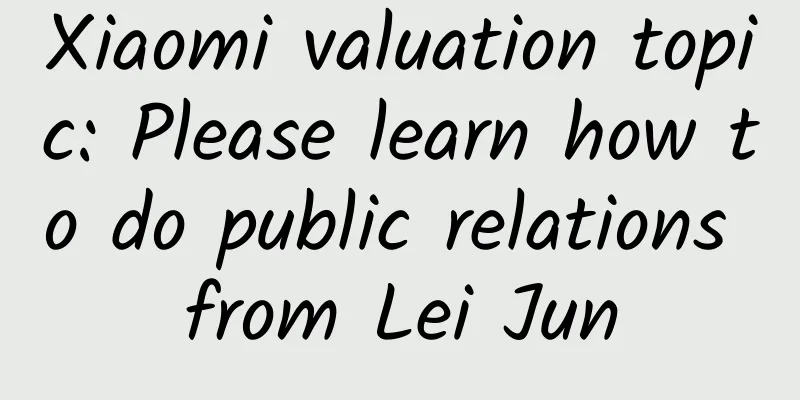Xiaomi valuation topic: Please learn how to do public relations from Lei Jun

|
Generally speaking, companies that hype valuation topics are mostly related to financing and asset integration. Valuation itself is a kind of preparation and foil. The topic of Xiaomi's valuation came a little suddenly. However, if you look back, even if you only see Lei Jun start to brag about the shipment volume on Weibo, you can get a glimpse of it. Let me put it this way. I think, from Lei Jun's rumor, to him suddenly bringing up the old topic of betting with Dong Mingzhu - please note that this round was initiated by him - to Li Wanqiang's trip to the United States, the company's internal executive adjustments, Xiaomi becoming the world's third largest company in Q3, and then Chen Tong coming in and emphasizing the internal layout. It is not good to speculate without reason. However, regardless of whether the internal PR level is sober and leading, from the overall logic, I think this does look like a complete communication case: When you link everything to valuation, you will find that the entire communication is just like the style of the Spring and Autumn Annals, which is a smooth and seamless process. It should be said that the communication effect is very good. If there is no preparation before, I think it is really magical. I have entered a free state from top to bottom. Xiaomi's mobile phone sales are good, but it is not as good as Xiaomi's communication. But this is not the most important thing. After all, communication is a whole, not just a matter of the PR department. Lei Jun is famous for his intelligence. However, despite the good results, it cannot cover up the unfavorable topics. After all, there are two sides to the same coin. The $40 billion valuation means that you are either very short of money - because the valuation has increased sharply, the corresponding financing amount should be large, or you need to integrate feature businesses, which means that your existing model is not so perfect. This involuntarily makes people think of: 1. Xiaomi’s capital chain and net profit performance; 2. Xiaomi’s model problems. Let's start with 1. Xiaomi should not worry about cash flow. People often say that Xiaomi's supply chain is awesome, which can be directly understood as awesome cash flow. As a symbol of the speed and passion of China's mobile Internet industry, Xiaomi's rapid scale and smart Internet marketing have attracted much attention. Xiaomi is also a quasi-financial survival model. For a company that was founded only more than 4 years ago, it is indeed very outstanding to achieve a revenue of 70 billion yuan a year. So Lei Jun has his own pride in comparing himself with Dong Mingzhu. But Xiaomi has never disclosed its net profit performance, which in itself reveals a problem. According to common sense, if the net profit is very good, just like Huawei, it dares to disclose it every year without going public. According to Xiaomi's current style, Lei Jun and Li Wanqiang should not be able to hold it back and will not deliberately hide it. If it does not actively disclose it, we can only understand from common sense that its net profit performance is not that good. Moreover, for startups, if they have revenue and profits, the more scientific valuation method is of course the price-earnings ratio method, that is, the product of profits and the industry's average price-earnings ratio can get a rough valuation. Putting aside the price-dream ratio, it is of course more beneficial to disclose net profits. Xiaomi does not disclose, so I still hold the view that it is not outstanding. Of course, not so good is only relative. The balance between Xiaomi's revenue and profit should still be good in the industry. A few days ago, Li Wanqiang disclosed Xiaomi's Q2 express delivery orders, a total of 10.31 million orders, 13.7 million invoices (including accessories), and online sales of more than 10 billion yuan. Among them, SF Express alone sent out 6.14 million express orders in Q2. A rough calculation shows that by dividing Xiaomi's Q2 online revenue of 10 billion yuan by the number of express delivery orders, we can get the average price of the products (including Xiaomi accessories of course). The corresponding average amount on each express delivery order is approximately 969 yuan, which is significantly higher than the unit price of Redmi, but significantly lower than the unit price of the new core products. The invoice quantity may be more core. It should involve product classification. Divide 10 billion by it, the result is 730 yuan, which is obviously lower than the unit price of Redmi. Here comes the problem: In the situation where Xiaomi TV has not really been mass-produced, the average price of a single invoice is lower than the price of Redmi, and is much lower than the main new high-end models, indicating that Xiaomi accessories account for a considerable proportion of shipments. This must involve the actual profit of Xiaomi. Although there is no single product information, I assert that it will not be too outstanding. In this case, Xiaomi should be short of money. The valuation topic is more like the rhythm of raising funds, that is, Lei Jun needs money. For this "fresh meat" company that has attracted much attention and has strong growth potential, it should not be difficult to get money. Moreover, Lei Jun's reputation and entrepreneurial journey have always been verified. However, how to raise its own valuation while getting money is more important. Therefore, we can see that there was a mysterious ritual of hype before the valuation topic came out. Moreover, when the valuation news was constantly released, the former Sina editor-in-chief Chen Tong joined, and Lei Jun promptly announced that he would invest $1 billion to strengthen the content layout. This is more like a deal that was finalized. The voice-over is that with a valuation of $40 billion, we have a very reasonable logic. You see, in addition to triathlon, I also have content layout. However, in my opinion, this is also not such a favorable topic. Lei Jun’s exaggeration of the urgency of content layout this time, and Chen Tong’s statement of military orders, saying that there must be subversive changes in half a year, shows that Xiaomi’s previous triathlon model still has many problems. Yesterday, when I was interviewed by China Business Network, I said frankly that if Xiaomi is regarded as a hardware terminal company, the valuation of $40 billion is too high, and it is not worth cutting it in half. Some people compare it with Lenovo's overall market value, which is unfair and ignores the richness of Lenovo's business, which is a bit unreliable. However, if we consider Xiaomi's triathlon, especially miui and the entire ecosystem, combined with Lei Jun's Shenma team, I don't think $40 billion can be said to be mysterious. Moreover, it is unfair to simply benchmark Samsung and Apple, which will ignore the market factors of Xiaomi's home country. This is the part I appreciate about it. But it cannot cover up the flaws in its model. Xiaomi's current model of simply selling mobile phones and accessories, even if MIUI can explode in the short term, I think it is unlikely to have a more powerful future. Sooner or later, the smartphone market will be relatively saturated, and shipments will definitely have a correction. Xiaomi TV has no real voice yet. Some people say that as long as the content is connected, there will be earth-shaking changes just like the military order issued by Chen Tong. I think this is too optimistic. Xiaomi simply sells TVs and boxes. The core constraint is not its model, but policy barriers. LeTV's predicament, in addition to possible political risks, has reflected the pressure from the policy side. The power from regulators has become a key factor influencing the current Internet TV market. This will directly affect Xiaomi's next round of competition. Of course, we can see that Xiaomi hardware has already entered the fields of smart home and industry applications, but the former is still subject to the above reasons, and the latter will not become its mainstream in the short term. Xiaomi is pinning its hopes on Chen Tong's military order, but it is not optimistic. Although Lei Jun said that Xiaomi will not produce content by itself, but will open up to cooperation - I assert that it will invest while building a content platform, but no matter how it is done, it cannot avoid the distribution link in the short term, which is not exactly the same as mobile phone content. Of course, if Xiaomi uses Chen Tong's power to hug regulators or parties with official media or license qualifications, and establishes connections with the latter through capital, it is feasible to see results in half a year. After all, if you expect to buy content, there are not many options. Overseas copyrights are becoming more and more difficult to land, and there are not many high-quality local content. There is no time for temporary production. In fact, this was also the advice I gave to LeTV two months ago. Of course, this does not hinder Xiaomi's progress. Moreover, strengthening content layout is indeed in line with Xiaomi's business logic. However, I think it has reached a transition window from speed and passion to a more stable ecological construction. Xiaomi needs to become more restrained, and even sacrifice a little speed to focus on upstream blending. Xiaomi still has a lot to settle. Just like the stock market, with multiple positive factors, you often open higher, but then you have to make up for the gaps. Those gaps may not necessarily mean a decline in performance, but they are likely to be cultural issues, especially within the organization, team, and system, involving corporate governance. Although Lei Jun has said that he will not go public within 5 years, things still need to be prepared. Otherwise, the $40 billion valuation will not make much sense. Therefore, on the topic of valuation, Lei Jun has given us another lesson about the communication and growth of Xiaomi's business model. However, Xiaomi itself may also need to take some notes on the other side of this lesson. As a winner of Toutiao's Qingyun Plan and Baijiahao's Bai+ Plan, the 2019 Baidu Digital Author of the Year, the Baijiahao's Most Popular Author in the Technology Field, the 2019 Sogou Technology and Culture Author, and the 2021 Baijiahao Quarterly Influential Creator, he has won many awards, including the 2013 Sohu Best Industry Media Person, the 2015 China New Media Entrepreneurship Competition Beijing Third Place, the 2015 Guangmang Experience Award, the 2015 China New Media Entrepreneurship Competition Finals Third Place, and the 2018 Baidu Dynamic Annual Powerful Celebrity. |
<<: Talking about the open Internet platform: "Decentralization" is the general trend
>>: Working is actually a hundred times harder than starting a business
Recommend
How to solve the pain points of community operations? I give these 8 suggestions!
Internet companies are very keen on creating comm...
Horse racing, live pigeon shooting... a list of the weird Olympic sports that have disappeared
In 2024, we are cheering for more than 300 events...
How should I operate a new Baidu bidding account? What should I pay attention to? Urgent!
(1). Choice of keywords: It depends on whether yo...
Apple Developer Conference preview: In addition to iOS 9, here are some other things to watch
[[135642]] The 2015 Apple WWDC Developer Conferen...
Android advanced Kotlin high-order functions and Lambda expressions detailed explanation
[[415968]] Preface Lambda syntax has been widely ...
Fried! Grilled! Smoked! Why is it so delicious?
The process of cooking food is also the process o...
How many ways can you use the TCL L55C1-CUD curved TV that can watch, sing and exercise?
Connecting a set-top box and watching high-defini...
Analyzing the 6 major ways in which online education blind boxes are growing!
1. What is a blind box? A blind box refers to a b...
How to carry out Shatin SEO optimization? How to optimize SEO?
Website optimization is divided into internal web...
China needs domestic enterprises to work together to gain 5G patent advantages
At MWC 2017, Huawei and ZTE, two Chinese companie...
People stranded in Hubei will undergo double nucleic acid testing when returning to Beijing, and safety work still needs to be done!
Beijing News Express (Reporter Sha Xueliang) On t...
Mobile APP development encounters bottleneck? What should developers do?
Editor's note: At present, there are enough m...
A review of the top ten public relations crisis events in 2018 (Part 1)
Today, I will use three crisis public relations t...
APP practical information: How to become a content operator from scratch!
At an accidental Shanghai (Smalltalk) operations ...
Why doesn't anyone like your ad?
I have been thinking about a question recently. I...









